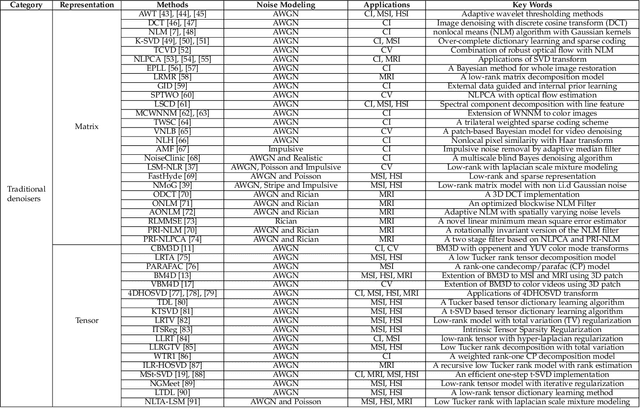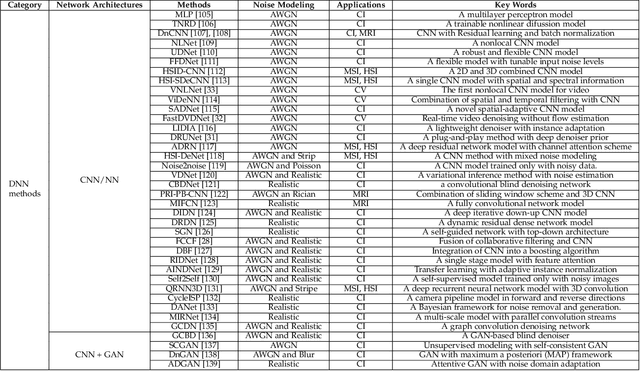Zhaoming Kong
Image Denoising Using Green Channel Prior
Aug 12, 2024Abstract:Image denoising is an appealing and challenging task, in that noise statistics of real-world observations may vary with local image contents and different image channels. Specifically, the green channel usually has twice the sampling rate in raw data. To handle noise variances and leverage such channel-wise prior information, we propose a simple and effective green channel prior-based image denoising (GCP-ID) method, which integrates GCP into the classic patch-based denoising framework. Briefly, we exploit the green channel to guide the search for similar patches, which aims to improve the patch grouping quality and encourage sparsity in the transform domain. The grouped image patches are then reformulated into RGGB arrays to explicitly characterize the density of green samples. Furthermore, to enhance the adaptivity of GCP-ID to various image contents, we cast the noise estimation problem into a classification task and train an effective estimator based on convolutional neural networks (CNNs). Experiments on real-world datasets demonstrate the competitive performance of the proposed GCP-ID method for image and video denoising applications in both raw and sRGB spaces. Our code is available at https://github.com/ZhaomingKong/GCP-ID.
Unleashing the Power of Multi-Task Learning: A Comprehensive Survey Spanning Traditional, Deep, and Pretrained Foundation Model Eras
Apr 29, 2024



Abstract:MTL is a learning paradigm that effectively leverages both task-specific and shared information to address multiple related tasks simultaneously. In contrast to STL, MTL offers a suite of benefits that enhance both the training process and the inference efficiency. MTL's key advantages encompass streamlined model architecture, performance enhancement, and cross-domain generalizability. Over the past twenty years, MTL has become widely recognized as a flexible and effective approach in various fields, including CV, NLP, recommendation systems, disease prognosis and diagnosis, and robotics. This survey provides a comprehensive overview of the evolution of MTL, encompassing the technical aspects of cutting-edge methods from traditional approaches to deep learning and the latest trend of pretrained foundation models. Our survey methodically categorizes MTL techniques into five key areas: regularization, relationship learning, feature propagation, optimization, and pre-training. This categorization not only chronologically outlines the development of MTL but also dives into various specialized strategies within each category. Furthermore, the survey reveals how the MTL evolves from handling a fixed set of tasks to embracing a more flexible approach free from task or modality constraints. It explores the concepts of task-promptable and -agnostic training, along with the capacity for ZSL, which unleashes the untapped potential of this historically coveted learning paradigm. Overall, we hope this survey provides the research community with a comprehensive overview of the advancements in MTL from its inception in 1997 to the present in 2023. We address present challenges and look ahead to future possibilities, shedding light on the opportunities and potential avenues for MTL research in a broad manner. This project is publicly available at https://github.com/junfish/Awesome-Multitask-Learning.
Color Image Denoising Using The Green Channel Prior
Feb 13, 2024Abstract:Noise removal in the standard RGB (sRGB) space remains a challenging task, in that the noise statistics of real-world images can be different in R, G and B channels. In fact, the green channel usually has twice the sampling rate in raw data and a higher signal-to-noise ratio than red/blue ones. However, the green channel prior (GCP) is often understated or ignored in color image denoising since many existing approaches mainly focus on modeling the relationship among image patches. In this paper, we propose a simple and effective one step GCP-based image denoising (GCP-ID) method, which aims to exploit the GCP for denoising in the sRGB space by integrating it into the classic nonlocal transform domain denoising framework. Briefly, we first take advantage of the green channel to guide the search of similar patches, which improves the patch search quality and encourages sparsity in the transform domain. Then we reformulate RGB patches into RGGB arrays to explicitly characterize the density of green samples. The block circulant representation is utilized to capture the cross-channel correlation and the channel redundancy. Experiments on both synthetic and real-world datasets demonstrate the competitive performance of the proposed GCP-ID method for the color image and video denoising tasks. The code is available at github.com/ZhaomingKong/GCP-ID.
A Comparison of Image Denoising Methods
Apr 18, 2023Abstract:The advancement of imaging devices and countless images generated everyday pose an increasingly high demand on image denoising, which still remains a challenging task in terms of both effectiveness and efficiency. To improve denoising quality, numerous denoising techniques and approaches have been proposed in the past decades, including different transforms, regularization terms, algebraic representations and especially advanced deep neural network (DNN) architectures. Despite their sophistication, many methods may fail to achieve desirable results for simultaneous noise removal and fine detail preservation. In this paper, to investigate the applicability of existing denoising techniques, we compare a variety of denoising methods on both synthetic and real-world datasets for different applications. We also introduce a new dataset for benchmarking, and the evaluations are performed from four different perspectives including quantitative metrics, visual effects, human ratings and computational cost. Our experiments demonstrate: (i) the effectiveness and efficiency of representative traditional denoisers for various denoising tasks, (ii) a simple matrix-based algorithm may be able to produce similar results compared with its tensor counterparts, and (iii) the notable achievements of DNN models, which exhibit impressive generalization ability and show state-of-the-art performance on various datasets. In spite of the progress in recent years, we discuss shortcomings and possible extensions of existing techniques. Datasets, code and results are made publicly available and will be continuously updated at https://github.com/ZhaomingKong/Denoising-Comparison.
Tensor-Based Multi-Modality Feature Selection and Regression for Alzheimer's Disease Diagnosis
Sep 23, 2022



Abstract:The assessment of Alzheimer's Disease (AD) and Mild Cognitive Impairment (MCI) associated with brain changes remains a challenging task. Recent studies have demonstrated that combination of multi-modality imaging techniques can better reflect pathological characteristics and contribute to more accurate diagnosis of AD and MCI. In this paper, we propose a novel tensor-based multi-modality feature selection and regression method for diagnosis and biomarker identification of AD and MCI from normal controls. Specifically, we leverage the tensor structure to exploit high-level correlation information inherent in the multi-modality data, and investigate tensor-level sparsity in the multilinear regression model. We present the practical advantages of our method for the analysis of ADNI data using three imaging modalities (VBM- MRI, FDG-PET and AV45-PET) with clinical parameters of disease severity and cognitive scores. The experimental results demonstrate the superior performance of our proposed method against the state-of-the-art for the disease diagnosis and the identification of disease-specific regions and modality-related differences. The code for this work is publicly available at https://github.com/junfish/BIOS22.
Multiplex Graph Networks for Multimodal Brain Network Analysis
Jul 31, 2021



Abstract:In this paper, we propose MGNet, a simple and effective multiplex graph convolutional network (GCN) model for multimodal brain network analysis. The proposed method integrates tensor representation into the multiplex GCN model to extract the latent structures of a set of multimodal brain networks, which allows an intuitive 'grasping' of the common space for multimodal data. Multimodal representations are then generated with multiplex GCNs to capture specific graph structures. We conduct classification task on two challenging real-world datasets (HIV and Bipolar disorder), and the proposed MGNet demonstrates state-of-the-art performance compared to competitive benchmark methods. Apart from objective evaluations, this study may bear special significance upon network theory to the understanding of human connectome in different modalities. The code is available at https://github.com/ZhaomingKong/MGNets.
A Comprehensive Comparison of Multi-Dimensional Image Denoising Methods
Nov 06, 2020



Abstract:Filtering multi-dimensional images such as color images, color videos, multispectral images and magnetic resonance images is challenging in terms of both effectiveness and efficiency. Leveraging the nonlocal self-similarity (NLSS) characteristic of images and sparse representation in the transform domain, the block-matching and 3D filtering (BM3D) based methods show powerful denoising performance. Recently, numerous new approaches with different regularization terms, transforms and advanced deep neural network (DNN) architectures are proposed to improve denoising quality. In this paper, we extensively compare over 60 methods on both synthetic and real-world datasets. We also introduce a new color image and video dataset for benchmarking, and our evaluations are performed from four different perspectives including quantitative metrics, visual effects, human ratings and computational cost. Comprehensive experiments demonstrate: (i) the effectiveness and efficiency of the BM3D family for various denoising tasks, (ii) a simple matrix-based algorithm could produce similar results compared with its tensor counterparts, and (iii) several DNN models trained with synthetic Gaussian noise show state-of-the-art performance on real-world color image and video datasets. Despite the progress in recent years, we discuss shortcomings and possible extensions of existing techniques. Datasets and codes for evaluation are made publicly available at https://github.com/ZhaomingKong/Denoising-Comparison.
Color Image and Multispectral Image Denoising Using Block Diagonal Representation
Feb 11, 2019



Abstract:Filtering images of more than one channel is challenging in terms of both efficiency and effectiveness. By grouping similar patches to utilize the self-similarity and sparse linear approximation of natural images, recent nonlocal and transform-domain methods have been widely used in color and multispectral image (MSI) denoising. Many related methods focus on the modeling of group level correlation to enhance sparsity, which often resorts to a recursive strategy with a large number of similar patches. The importance of the patch level representation is understated. In this paper, we mainly investigate the influence and potential of representation at patch level by considering a general formulation with block diagonal matrix. We further show that by training a proper global patch basis, along with a local principal component analysis transform in the grouping dimension, a simple transform-threshold-inverse method could produce very competitive results. Fast implementation is also developed to reduce computational complexity. Extensive experiments on both simulated and real datasets demonstrate its robustness, effectiveness and efficiency.
A Brief Review of Real-World Color Image Denoising
Sep 10, 2018



Abstract:Filtering real-world color images is challenging due to the complexity of noise that can not be formulated as a certain distribution. However, the rapid development of camera lens pos- es greater demands on image denoising in terms of both efficiency and effectiveness. Currently, the most widely accepted framework employs the combination of transform domain techniques and nonlocal similarity characteristics of natural images. Based on this framework, many competitive methods model the correlation of R, G, B channels with pre-defined or adaptively learned transforms. In this chapter, a brief review of related methods and publicly available datasets is presented, moreover, a new dataset that includes more natural outdoor scenes is introduced. Extensive experiments are performed and discussion on visual effect enhancement is included.
 Add to Chrome
Add to Chrome Add to Firefox
Add to Firefox Add to Edge
Add to Edge